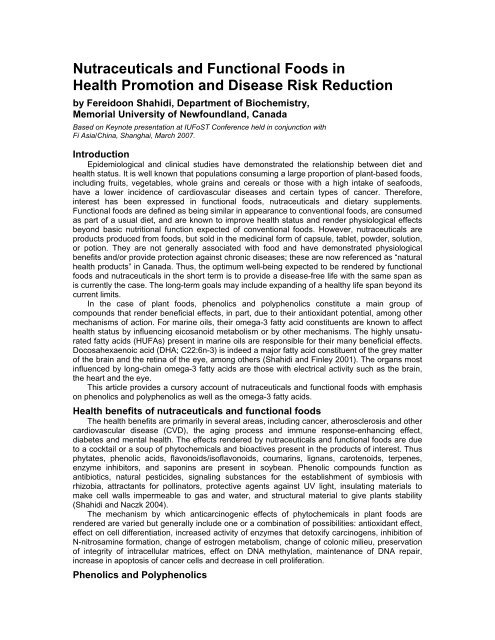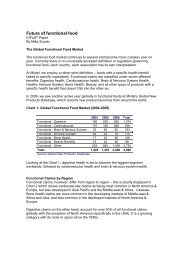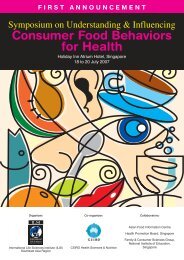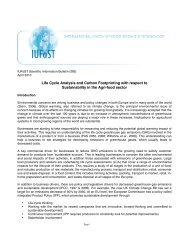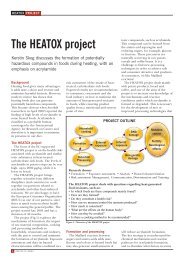Nutraceuticals and Functional Foods in - World Food Science
Nutraceuticals and Functional Foods in - World Food Science
Nutraceuticals and Functional Foods in - World Food Science
You also want an ePaper? Increase the reach of your titles
YUMPU automatically turns print PDFs into web optimized ePapers that Google loves.
<strong>Nutraceuticals</strong> <strong>and</strong> <strong>Functional</strong> <strong><strong>Food</strong>s</strong> <strong>in</strong><br />
Health Promotion <strong>and</strong> Disease Risk Reduction<br />
by Fereidoon Shahidi, Department of Biochemistry,<br />
Memorial University of Newfoundl<strong>and</strong>, Canada<br />
Based on Keynote presentation at IUFoST Conference held <strong>in</strong> conjunction with<br />
Fi Asia/Ch<strong>in</strong>a, Shanghai, March 2007.<br />
Introduction<br />
Epidemiological <strong>and</strong> cl<strong>in</strong>ical studies have demonstrated the relationship between diet <strong>and</strong><br />
health status. It is well known that populations consum<strong>in</strong>g a large proportion of plant-based foods,<br />
<strong>in</strong>clud<strong>in</strong>g fruits, vegetables, whole gra<strong>in</strong>s <strong>and</strong> cereals or those with a high <strong>in</strong>take of seafoods,<br />
have a lower <strong>in</strong>cidence of cardiovascular diseases <strong>and</strong> certa<strong>in</strong> types of cancer. Therefore,<br />
<strong>in</strong>terest has been expressed <strong>in</strong> functional foods, nutraceuticals <strong>and</strong> dietary supplements.<br />
<strong>Functional</strong> foods are def<strong>in</strong>ed as be<strong>in</strong>g similar <strong>in</strong> appearance to conventional foods, are consumed<br />
as part of a usual diet, <strong>and</strong> are known to improve health status <strong>and</strong> render physiological effects<br />
beyond basic nutritional function expected of conventional foods. However, nutraceuticals are<br />
products produced from foods, but sold <strong>in</strong> the medic<strong>in</strong>al form of capsule, tablet, powder, solution,<br />
or potion. They are not generally associated with food <strong>and</strong> have demonstrated physiological<br />
benefits <strong>and</strong>/or provide protection aga<strong>in</strong>st chronic diseases; these are now referenced as “natural<br />
health products” <strong>in</strong> Canada. Thus, the optimum well-be<strong>in</strong>g expected to be rendered by functional<br />
foods <strong>and</strong> nutraceuticals <strong>in</strong> the short term is to provide a disease-free life with the same span as<br />
is currently the case. The long-term goals may <strong>in</strong>clude exp<strong>and</strong><strong>in</strong>g of a healthy life span beyond its<br />
current limits.<br />
In the case of plant foods, phenolics <strong>and</strong> polyphenolics constitute a ma<strong>in</strong> group of<br />
compounds that render beneficial effects, <strong>in</strong> part, due to their antioxidant potential, among other<br />
mechanisms of action. For mar<strong>in</strong>e oils, their omega-3 fatty acid constituents are known to affect<br />
health status by <strong>in</strong>fluenc<strong>in</strong>g eicosanoid metabolism or by other mechanisms. The highly unsaturated<br />
fatty acids (HUFAs) present <strong>in</strong> mar<strong>in</strong>e oils are responsible for their many beneficial effects.<br />
Docosahexaenoic acid (DHA; C22:6n-3) is <strong>in</strong>deed a major fatty acid constituent of the grey matter<br />
of the bra<strong>in</strong> <strong>and</strong> the ret<strong>in</strong>a of the eye, among others (Shahidi <strong>and</strong> F<strong>in</strong>ley 2001). The organs most<br />
<strong>in</strong>fluenced by long-cha<strong>in</strong> omega-3 fatty acids are those with electrical activity such as the bra<strong>in</strong>,<br />
the heart <strong>and</strong> the eye.<br />
This article provides a cursory account of nutraceuticals <strong>and</strong> functional foods with emphasis<br />
on phenolics <strong>and</strong> polyphenolics as well as the omega-3 fatty acids.<br />
Health benefits of nutraceuticals <strong>and</strong> functional foods<br />
The health benefits are primarily <strong>in</strong> several areas, <strong>in</strong>clud<strong>in</strong>g cancer, atherosclerosis <strong>and</strong> other<br />
cardiovascular disease (CVD), the ag<strong>in</strong>g process <strong>and</strong> immune response-enhanc<strong>in</strong>g effect,<br />
diabetes <strong>and</strong> mental health. The effects rendered by nutraceuticals <strong>and</strong> functional foods are due<br />
to a cocktail or a soup of phytochemicals <strong>and</strong> bioactives present <strong>in</strong> the products of <strong>in</strong>terest. Thus<br />
phytates, phenolic acids, flavonoids/isoflavonoids, coumar<strong>in</strong>s, lignans, carotenoids, terpenes,<br />
enzyme <strong>in</strong>hibitors, <strong>and</strong> sapon<strong>in</strong>s are present <strong>in</strong> soybean. Phenolic compounds function as<br />
antibiotics, natural pesticides, signal<strong>in</strong>g substances for the establishment of symbiosis with<br />
rhizobia, attractants for poll<strong>in</strong>ators, protective agents aga<strong>in</strong>st UV light, <strong>in</strong>sulat<strong>in</strong>g materials to<br />
make cell walls impermeable to gas <strong>and</strong> water, <strong>and</strong> structural material to give plants stability<br />
(Shahidi <strong>and</strong> Naczk 2004).<br />
The mechanism by which anticarc<strong>in</strong>ogenic effects of phytochemicals <strong>in</strong> plant foods are<br />
rendered are varied but generally <strong>in</strong>clude one or a comb<strong>in</strong>ation of possibilities: antioxidant effect,<br />
effect on cell differentiation, <strong>in</strong>creased activity of enzymes that detoxify carc<strong>in</strong>ogens, <strong>in</strong>hibition of<br />
N-nitrosam<strong>in</strong>e formation, change of estrogen metabolism, change of colonic milieu, preservation<br />
of <strong>in</strong>tegrity of <strong>in</strong>tracellular matrices, effect on DNA methylation, ma<strong>in</strong>tenance of DNA repair,<br />
<strong>in</strong>crease <strong>in</strong> apoptosis of cancer cells <strong>and</strong> decrease <strong>in</strong> cell proliferation.<br />
Phenolics <strong>and</strong> Polyphenolics
Phenolic compounds are among phytochemicals that may render their effects via<br />
antioxidation <strong>and</strong> relief from oxidative stress <strong>and</strong> its consequences. In general, free radicals are<br />
part of life as we consume some 3.5 kg of oxygen each day, some of which is not completely<br />
reduced, thus lead<strong>in</strong>g to the formation of free radicals <strong>and</strong> other reactive oxygen species (ROS)<br />
such as superoxide, hydroxyl radical, peroxyl radical, <strong>and</strong> alkoxyl radical, as well as hydrogen<br />
peroxide <strong>and</strong> other peroxides. Therefore, several kilograms of peroxides <strong>and</strong> other ROS may be<br />
produced <strong>in</strong> our body each year. Many diseases are caused by excess ROS. In healthy<br />
<strong>in</strong>dividuals, free radicals <strong>and</strong> other ROS are neutralized by antioxidant defence mechanisms <strong>in</strong><br />
the body, <strong>in</strong>clud<strong>in</strong>g superoxide dismutase <strong>and</strong> glutathione, among others. However, endogenous<br />
systems may not provide sufficient protection <strong>in</strong> <strong>in</strong>dividuals suffer<strong>in</strong>g from certa<strong>in</strong> diseases; <strong>in</strong><br />
such cases help from dietary sources is important.<br />
The antioxidative effect of phenolics (Shahidi 1997) <strong>in</strong> functional foods is due to a direct free<br />
radical scaveng<strong>in</strong>g activity (Halliwell 1996; Shahidi 2000; Shahidi <strong>and</strong> Ho 2007; Wettas<strong>in</strong>ghe <strong>and</strong><br />
Shahidi 1999a,b), reduc<strong>in</strong>g activity <strong>and</strong> an <strong>in</strong>direct effect aris<strong>in</strong>g from chelation of prooxidant<br />
metal ions. The chelation of metal ions generally requires ortho-dihydroxylation on the phenyl r<strong>in</strong>g<br />
<strong>in</strong> phenolic acids <strong>and</strong> flavonoids or the presence of a 3- or 5-hydroxyl group <strong>in</strong> flavonoids.<br />
The endogenous phenolics <strong>in</strong> plant foods are the largest group of secondary metabolites<br />
orig<strong>in</strong>at<strong>in</strong>g from phenylalan<strong>in</strong>e <strong>and</strong>, to a lesser extent, <strong>in</strong> some plants from tyros<strong>in</strong>e via the action<br />
of phenylalan<strong>in</strong>e ammonia lyase (PAL) <strong>and</strong> tyros<strong>in</strong>e ammonia lyase (TAL), respectively (Shahidi<br />
<strong>and</strong> Naczk 2004). The respective products are c<strong>in</strong>namic acid <strong>and</strong> p-couramic acid that serve as<br />
the ma<strong>in</strong> phenylpropanoid (C6-C3) compounds <strong>and</strong> these lead to the formation of benzoic acid<br />
(C6-C1) derivatives by loss of a 2-carbon moiety as well as to chalcones (C6-C3-C6), stilbenes<br />
(C6-C2-C6), <strong>and</strong> flavonoids (C6-C3-C6) by comb<strong>in</strong>ation with 3 molecules of malonyl coenzyme A.<br />
However, tann<strong>in</strong>s, both condensed <strong>and</strong> hydrolyzable, produced via condensation of flavan-1,3-<br />
diol molecules with one another or via reaction of gallic acid with sugars, respectively, are among<br />
phenolics that are better known for their effect on precipitat<strong>in</strong>g prote<strong>in</strong>s <strong>and</strong>, hence, their ant<strong>in</strong>utritional<br />
effect. However, even these latter compounds are known to exert health benefits which<br />
generally follow a mechanism similar to that known for their anti-nutritional activity.<br />
Among plant materials, fruits <strong>and</strong> vegetables conta<strong>in</strong> phenolics, ma<strong>in</strong>ly belong<strong>in</strong>g to the<br />
flavonoids family, but also phenolic acids. Meanwhile, cereals conta<strong>in</strong> a wide range of phenolic<br />
acids, belong<strong>in</strong>g ma<strong>in</strong>ly to the benzoic acid <strong>and</strong> c<strong>in</strong>namic acid groups. Phenolic acids are different<br />
from other phenolic compounds by bear<strong>in</strong>g acidic properties due to the presence of a<br />
carboxylic acid group. Ferulic acid <strong>and</strong> p-coumaric acid are the major phenolic acids found <strong>in</strong><br />
many cereals, <strong>in</strong>clud<strong>in</strong>g barley (Liyana-pathirana <strong>and</strong> Shahidi 2004). A significant proportion of<br />
these phenolic acids are l<strong>in</strong>ked to lignans <strong>and</strong> arab<strong>in</strong>oxylans (Nordkvist et al. 1984). Ferulic acid<br />
is highly concentrated <strong>in</strong> the cell walls of aleurone layer that is rich <strong>in</strong> arab<strong>in</strong>oxylan. Phenolic<br />
compounds <strong>in</strong> cereal gra<strong>in</strong>s can be found <strong>in</strong> the free, soluble conjugate or esterified, <strong>and</strong><br />
<strong>in</strong>soluble-bound forms. It is reported that 74 <strong>and</strong> 69% of total phenolics present <strong>in</strong> rice <strong>and</strong> corn,<br />
respectively, are <strong>in</strong> the <strong>in</strong>soluble-bound form (Adom <strong>and</strong> Liu, 2002). Most of the studies found <strong>in</strong><br />
the literature so far have not looked <strong>in</strong>to <strong>in</strong>soluble-bound phenolic compounds, hence results<br />
reported are often underestimated.<br />
Phenolic esters can be hydrolyzed to release phenolic acids by different means. Alkal<strong>in</strong>e,<br />
acidic or enzymatic hydrolysis methods are adopted <strong>in</strong> order to release <strong>in</strong>soluble-bound phenolics<br />
from the cereal matrix (Liyanapathirana <strong>and</strong> Shahidi 2004). Generally, alkal<strong>in</strong>e hydrolysis is the<br />
method mostly used for extract<strong>in</strong>g esterified or bound phenolics at room temperature <strong>and</strong> we also<br />
used alkal<strong>in</strong>e hydrolysis to release phenolic acids present <strong>in</strong> the <strong>in</strong>soluble-bound form.<br />
We have demonstrated that while free phenolics <strong>in</strong> barley extracts are present at 0.18-0.42<br />
mg ferulic acid equivalents per gram of material, the soluble conjugates occur at 0.42-0.81 <strong>and</strong><br />
<strong>in</strong>soluble-bound fraction at 2.03-3.36 mg/g as ferulic acid equivalents. Meanwhile, wheat <strong>and</strong> its<br />
by-products conta<strong>in</strong>ed >80% of their total phenolics <strong>in</strong> the bound form. The content of bound<br />
phenolics <strong>in</strong> the whole gra<strong>in</strong> <strong>in</strong> hard <strong>and</strong> soft wheat was 22 <strong>and</strong> 18.5 times higher than the total of<br />
free <strong>and</strong> soluble esters, respectively.<br />
Adom <strong>and</strong> Liu (2002) analyzed a number of cereals, namely corn, wheat, oat <strong>and</strong> rice <strong>and</strong><br />
reported that corn had the highest free phenolic content (0.411 mg/g of gra<strong>in</strong>), followed by rice<br />
(0.407 mg/g of gra<strong>in</strong>), then wheat (0.368 mg/g of gra<strong>in</strong>), <strong>and</strong> oat (0.343 mg/g of gra<strong>in</strong>). The<br />
content of <strong>in</strong>soluble-bound phenolic was significantly higher among all of the above cereals.
LDL cholesterol oxidation, DNA nick<strong>in</strong>g <strong>and</strong> proliferation<br />
Oxidation of cholesterol leads to the formation of a plaque <strong>in</strong> the arteries <strong>and</strong>, hence, is a<br />
lead<strong>in</strong>g cause of cardiovascular disease. Phenolics <strong>and</strong> polyphenolics <strong>in</strong> foods <strong>and</strong> plant-based<br />
source materials are expected to have a positive effect on prevention of low-density lipoprote<strong>in</strong><br />
(LDL) cholesterol oxidation which may be exerted by a free radical scaveng<strong>in</strong>g mechanism<br />
(Siriwardhana <strong>and</strong> Shahidi 2002). In a study on almond <strong>and</strong> hazelnut, we found that extracts of<br />
almond <strong>and</strong> hazelnut, to a large extent, <strong>in</strong>hibited copper-<strong>in</strong>duced LDL cholesterol oxidation.<br />
Brown sk<strong>in</strong>s over almond <strong>and</strong> hazelnut flesh had a much higher activity than the whole nuts,<br />
presumably due to the presence of a large proportion of polyphenolic compounds <strong>in</strong> them than<br />
those <strong>in</strong> the flesh. The beneficial effects of a hazelnut-enriched diet on plasma cholesterol profile<br />
of hypercholesterolemic men was recently reported (Mercerligil et al. 2007). Similarly, mutation of<br />
deoxyribonucleic acid (DNA) <strong>and</strong> its breakdown may serve as a ma<strong>in</strong> cause of cancer <strong>in</strong> humans.<br />
We found that nick<strong>in</strong>g of DNA, <strong>in</strong>duced by peroxyl radical, <strong>in</strong> an <strong>in</strong> vitro study, was largely<br />
<strong>in</strong>hibited by extracts of nuts such as almond <strong>and</strong> their products. Aga<strong>in</strong>, results demonstrated that<br />
certa<strong>in</strong> components of food that are usually removed <strong>and</strong> discarded dur<strong>in</strong>g bleach<strong>in</strong>g, ref<strong>in</strong><strong>in</strong>g,<br />
<strong>and</strong> process<strong>in</strong>g are essential for health promotion <strong>and</strong> disease prevention. F<strong>in</strong>ally, whole barley<br />
extracts were found to be effective aga<strong>in</strong>st proliferation of Caco-2- human cancer cells. The<br />
<strong>in</strong>hibition effect of whole barley extract was 20.5-42.6% at a 0.5 mg/mL <strong>and</strong> values so obta<strong>in</strong>ed<br />
correlated well with Trolox equivalent antioxidant capacity (TEAC) <strong>and</strong> total phenolic contents<br />
(TPC). Parry et al. (2006) also found that extracts of fruit seed flours were effective aga<strong>in</strong>st<br />
proliferation of Caco-2 cells.<br />
Fish oils <strong>and</strong> their health effects<br />
A close scrut<strong>in</strong>y of the dietary fat <strong>in</strong>take of Eskimos <strong>and</strong> Danish populations showed that,<br />
while the energy from fat <strong>in</strong>take was similar <strong>in</strong> both groups, <strong>and</strong> despite a higher <strong>in</strong>take of<br />
cholesterol (790 mg/day) by Eskimos compared to Danes (420 mg/day), the <strong>in</strong>cidence of myocardial<br />
<strong>in</strong>farction (MI) <strong>in</strong> the former group was only 7% of that <strong>in</strong> the latter one (Dyerberg et al.<br />
1975; Bang et al. 1976). Further analysis of lipid constituents <strong>in</strong> the two groups <strong>in</strong>dicated that,<br />
<strong>in</strong>deed, the Eskimos consumed a much higher level of n-3 PUFA, ma<strong>in</strong>ly from dietary <strong>in</strong>take of<br />
mar<strong>in</strong>e foods, pr<strong>in</strong>cipally fish <strong>and</strong> seal, than the Danish population; the latter group used only<br />
10% of n-3 PUFA that was consumed by the Eskimos. To elaborate on the beneficial effects of<br />
mar<strong>in</strong>e oils <strong>in</strong> the prevention of MI, one may consider 3 stages associated with heart attacks.<br />
These <strong>in</strong>clude <strong>in</strong>jury to the coronary artery wall, build-up of a fatty fibrous plaque <strong>in</strong> the arteries,<br />
known as atherosclerosis, <strong>and</strong> formation of a blood clot, known as thrombosis. If a clot forms <strong>in</strong><br />
an artery which is already constricted by atherosclerosis, a heart attack may occur. Consumption<br />
of mar<strong>in</strong>e oils leads to th<strong>in</strong>n<strong>in</strong>g of blood, lower<strong>in</strong>g of triacylglycerol <strong>and</strong>, possibly, cholesterol<br />
levels <strong>and</strong>, hence, clot formation as well as fat deposition. Thus, <strong>in</strong>take of 24 g of fish/day<br />
<strong>in</strong>creased the survival rate from coronary heart disease by some 20% over a period of 16 years.<br />
In another study, it was found that breast-feed<strong>in</strong>g had a direct positive effect on verbal skill,<br />
performance skill, <strong>and</strong> overall IQ of <strong>in</strong>fants <strong>in</strong> comparison with their formula-fed counterparts. The<br />
difference <strong>in</strong> all of these was 8.1 to 8.9%. Furthermore, DHA status of maternal plasma<br />
phospholipids decreased by some 40% dur<strong>in</strong>g pregnancy, especially dur<strong>in</strong>g the last trimester.<br />
This is due to the essentiality of DHA <strong>in</strong> the development of the grey matter of the bra<strong>in</strong> as well as<br />
the ret<strong>in</strong>a of the eye <strong>and</strong> the components of the heart of the fetus (Shahidi <strong>and</strong> F<strong>in</strong>ley 2001).<br />
Omega-3 fatty acids, <strong>in</strong>clud<strong>in</strong>g DHA, orig<strong>in</strong>ate from phytoplankton <strong>and</strong> algae <strong>and</strong> are<br />
transferred to fish through the food web. Mar<strong>in</strong>e species are, hence, rich <strong>in</strong> omega-3 fatty acids<br />
<strong>and</strong> the correspond<strong>in</strong>g oils are obta<strong>in</strong>ed from the flesh of fatty fish such as herr<strong>in</strong>g <strong>and</strong> mackerel,<br />
liver of white lean fish such as cod <strong>and</strong> halibut <strong>and</strong> blubber of mar<strong>in</strong>e mammals such as seals<br />
<strong>and</strong> whales. Mar<strong>in</strong>e oils conta<strong>in</strong> a generally high level of long-cha<strong>in</strong> omega-3 PUFA (Shahidi<br />
2000b). This leads to high sensitivity of the oil to oxidative deterioration <strong>and</strong> off-flavor formation.<br />
Thus the oils need to be subjected to ref<strong>in</strong><strong>in</strong>g, bleach<strong>in</strong>g, <strong>and</strong> deodorization (RBD). The f<strong>in</strong>al RBD<br />
oil needs to be stabilized by appropriate antioxidants <strong>in</strong> order to elim<strong>in</strong>ate the deleterious effects<br />
of oxidized compounds <strong>and</strong> to take advantage of the beneficial health effects of their omega-3<br />
components without changes <strong>in</strong> their sensory quality (Shahidi <strong>and</strong> Kim 2002).<br />
Products <strong>in</strong> which mar<strong>in</strong>e oils may be <strong>in</strong>corporated <strong>in</strong>clude bread, cereal products, spread,<br />
milk, mayonnaise <strong>and</strong> salad dress<strong>in</strong>g, crackers <strong>and</strong> bars, as well as <strong>in</strong>fant formulas. The oils may
e microencapsulated <strong>and</strong> then used <strong>in</strong> different applications. However, the solid microcapsule<br />
particles must be washed properly with a nonpolar solvent to remove any unencapsulated oil that<br />
may otherwise be oxidized. However, application of the oil is most successful <strong>in</strong> products that are<br />
usually consumed with<strong>in</strong> a short period of time. Our experience shows that bread <strong>and</strong> milk<br />
products, commonly used with<strong>in</strong> 2 weeks from their production date, may well serve as the best<br />
carriers for omega-3 fatty acids (Alasalvar et al. 2002).<br />
Multi-component Systems Conta<strong>in</strong><strong>in</strong>g Phenolics<br />
In an effort to produce multi-component nutraceutical <strong>in</strong>gredients conta<strong>in</strong><strong>in</strong>g both mar<strong>in</strong>e oils<br />
<strong>and</strong> polyphenols, we used dechlorophyllized green tea extracts <strong>and</strong> seal oil as well as menhaden<br />
oil. The products obta<strong>in</strong>ed were found to be more stable to oxidation than oils devoid of tea<br />
catech<strong>in</strong>s. However, if the samples were not dechlorophyllized, the stabiliz<strong>in</strong>g effect of catech<strong>in</strong>s<br />
was counteracted by the photosensitiz<strong>in</strong>g effect of chlorophylls, hence destabilization of the oils<br />
(Wanasundara <strong>and</strong> Shahidi 1998).<br />
A considerable amount of m<strong>in</strong>or components <strong>in</strong> the oils with bioactivity may be removed by<br />
over-process<strong>in</strong>g of edible oils. Although removal of off-flavor components <strong>and</strong> environmental<br />
pollutants from edible products by process<strong>in</strong>g is essential, the bioactives present could be<br />
recovered <strong>and</strong> returned to the oils. Similarly, debrann<strong>in</strong>g of cereal gra<strong>in</strong>s would lead to the<br />
removal of bioactives that are concentrated <strong>in</strong> the outer layers, ma<strong>in</strong>ly the bran. Addition of<br />
seeds, rais<strong>in</strong> <strong>and</strong> nuts to whole gra<strong>in</strong> bread would also enhance its antioxidant potential <strong>and</strong> its<br />
health benefits.<br />
Conclusions<br />
<strong>Functional</strong> foods <strong>and</strong> nutraceuticals may provide a means to reduce the <strong>in</strong>creas<strong>in</strong>g burden on<br />
the health care system by a cont<strong>in</strong>uous preventive mechanism. A large number of<br />
phytochemicals <strong>and</strong> bioactives are present <strong>in</strong> foods of plant orig<strong>in</strong> as well as seafoods <strong>and</strong> other<br />
animal-based products. The synergistic effects rendered by a comb<strong>in</strong>ation of bioactives present<br />
<strong>in</strong> source materials <strong>and</strong> the complementary nature of phytochemicals from different sources are<br />
important factors to consider <strong>in</strong> the formulation of functional foods <strong>and</strong> <strong>in</strong> the choice of a healthy<br />
diet.<br />
References<br />
Adom KK, Liu RH. 2002. Antioxidant activity of gra<strong>in</strong>s. J Agric <strong>Food</strong> Chem 50: 6182-6187.<br />
Alasalvar C, Shahidi F, Quantick P. 2002. <strong>Food</strong> <strong>and</strong> health applications of mar<strong>in</strong>e nutraceuticals: a review. In: Alasalvar C, Taylor D, editors. Seafoods-Quality,<br />
technology <strong>and</strong> nutraceutical applications. New York: Spr<strong>in</strong>ger-Verlag. P 175-204.<br />
Bang HO, Dyerberg J, Hjorne N. 1976. The composition of food used by Greenl<strong>and</strong> Eskimos. Acta Med Sc<strong>and</strong> 200: 59-62.<br />
Dyberberg J, Bang HO, Hjorne N. 1975. Fatty acid compositions of the plasma lipids <strong>in</strong> Greenl<strong>and</strong> Eskimos. J Am Cl<strong>in</strong> Nutr 28: 958-62.<br />
Halliwell B. 1996. Antioxidants <strong>in</strong> human health <strong>and</strong> disease. Ann Rev Nutr 16: 33-50.<br />
Liyanapathirana CM, Shahidi F. 2004. Antioxidant activity of wheat extracts as affected by <strong>in</strong> vitro digestion. Biofactors 21: 325-328.<br />
Mercanligil SM, Arslan P, Alasalvar C, Okut E, Akgul E, P<strong>in</strong>ar A, Geyik PO, Tokgozoglu L, Shahidi F. 2007. Effect of hazelnut enriched diet on plasma cholesterol<br />
<strong>and</strong> lipoprote<strong>in</strong> profiles <strong>in</strong> hypercholesterolemic men. Eur J Cl<strong>in</strong> Nutr 61: 212-220.<br />
Nordvisk E, Salomonsson AC, Aman P. 1984. Distribution of <strong>in</strong>soluble bound phenolic acids <strong>in</strong> barley gra<strong>in</strong>s. J Sci <strong>Food</strong> Agric 35: 657-661.<br />
Shahidi F. 1997. Natural antioxidants: an overview. In: Shahidi F, Natural antioxidants: Chemistry, health effects <strong>and</strong> applications. Champaign, IL: AOCS Press. P.<br />
1-7.<br />
Shahidi F. 2000. Antioxidants <strong>in</strong> food <strong>and</strong> food antioxidants. Nahrung 44: 158-63.<br />
Shahidi F. 2000b. Seafoods <strong>in</strong> health <strong>and</strong> nutrition: Transformation <strong>in</strong> fisheries <strong>and</strong> aquaculture – Global perspectives. St. John’s, NL, Canada: <strong>Science</strong>Tech.<br />
Publish<strong>in</strong>g Co.<br />
Shahidi F, Ho C-T. 2000. Phytochemicals <strong>and</strong> phytopharmaceuticals. Champaign, IL: ACS Press.<br />
Shahidi F, Ho C-T. 2007. Antioxidant measurement <strong>and</strong> applications. ACS Symposium Series 956. American Chemical Society, Wash<strong>in</strong>gton DC.<br />
Shahidi F, F<strong>in</strong>ely JW. 2001. Omega-3 fatty acids: Chemistry, nutrition <strong>and</strong> health effects. ACS Symposium Series 788. Wash<strong>in</strong>gton, D.C.: American Chemical<br />
Society.<br />
Shahidi F, Kim S-K. 2002. Quality management of mar<strong>in</strong>e nutraceuticals. In: Ho C-T, Zheng QY, editors. Quality management of nutraceuticals. ACS Symposium<br />
Series 803. Wash<strong>in</strong>gton, D.C.: American Chemical Society. P. 76-87.<br />
Shahidi F, Naczk M. 2004. Phenolics <strong>in</strong> food <strong>and</strong> nutraceuticals. Boca Raton, FL: CRC Press.<br />
Siriw<strong>and</strong>hana SSKW, Shahidi F. 2002. Anti-radical activity of extracts of almond <strong>and</strong> its by-products. J Am Oil Chem Soc 79: 903-8.<br />
Wanasundara UN, Shahidi F. 1998. Antioxidant <strong>and</strong> pro-oxidant activity of green tea extraction <strong>in</strong> mar<strong>in</strong>e oils. <strong>Food</strong> Chem 63: 335-42.<br />
Wettas<strong>in</strong>ghe M, Shahidi F. 1999a. Even<strong>in</strong>g primrose meal: A source of natural antioxidants <strong>and</strong> scavengers of hydrogen peroxide <strong>and</strong> oxygen free radicals. J Agric<br />
<strong>Food</strong> Chem 47: 1801-12.<br />
Wettas<strong>in</strong>ghe M, Shahidi F. 1999b. Antioxidant <strong>and</strong> free radical scaveng<strong>in</strong>g properties of ethanolic extracts of defatted borage (Borago borealis L.) seeds. <strong>Food</strong><br />
Chem 67: 399-414.


